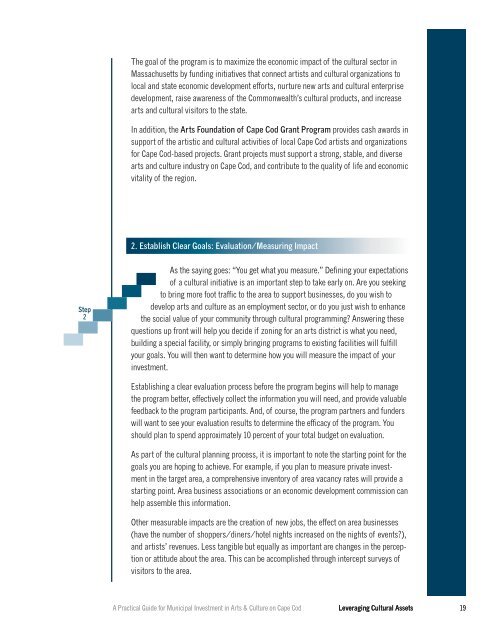Leveraging Cultural Assets for Economic Development - Cape Cod ...
Leveraging Cultural Assets for Economic Development - Cape Cod ...
Leveraging Cultural Assets for Economic Development - Cape Cod ...
- No tags were found...
Create successful ePaper yourself
Turn your PDF publications into a flip-book with our unique Google optimized e-Paper software.
The goal of the program is to maximize the economic impact of the cultural sector inMassachusetts by funding initiatives that connect artists and cultural organizations tolocal and state economic development ef<strong>for</strong>ts, nurture new arts and cultural enterprisedevelopment, raise awareness of the Commonwealth’s cultural products, and increasearts and cultural visitors to the state.In addition, the Arts Foundation of <strong>Cape</strong> <strong>Cod</strong> Grant Program provides cash awards insupport of the artistic and cultural activities of local <strong>Cape</strong> <strong>Cod</strong> artists and organizations<strong>for</strong> <strong>Cape</strong> <strong>Cod</strong>-based projects. Grant projects must support a strong, stable, and diversearts and culture industry on <strong>Cape</strong> <strong>Cod</strong>, and contribute to the quality of life and economicvitality of the region.2. Establish Clear Goals: Evaluation/Measuring ImpactStep2As the saying goes: “You get what you measure.” Defining your expectationsof a cultural initiative is an important step to take early on. Are you seekingto bring more foot traffic to the area to support businesses, do you wish todevelop arts and culture as an employment sector, or do you just wish to enhancethe social value of your community through cultural programming? Answering thesequestions up front will help you decide if zoning <strong>for</strong> an arts district is what you need,building a special facility, or simply bringing programs to existing facilities will fulfillyour goals. You will then want to determine how you will measure the impact of yourinvestment.Establishing a clear evaluation process be<strong>for</strong>e the program begins will help to managethe program better, effectively collect the in<strong>for</strong>mation you will need, and provide valuablefeedback to the program participants. And, of course, the program partners and funderswill want to see your evaluation results to determine the efficacy of the program. Youshould plan to spend approximately 10 percent of your total budget on evaluation.As part of the cultural planning process, it is important to note the starting point <strong>for</strong> thegoals you are hoping to achieve. For example, if you plan to measure private investmentin the target area, a comprehensive inventory of area vacancy rates will provide astarting point. Area business associations or an economic development commission canhelp assemble this in<strong>for</strong>mation.Other measurable impacts are the creation of new jobs, the effect on area businesses(have the number of shoppers/diners/hotel nights increased on the nights of events?),and artists’ revenues. Less tangible but equally as important are changes in the perceptionor attitude about the area. This can be accomplished through intercept surveys ofvisitors to the area.A Practical Guide <strong>for</strong> Municipal Investment in Arts & Culture on <strong>Cape</strong> <strong>Cod</strong> <strong>Leveraging</strong> <strong>Cultural</strong> <strong>Assets</strong> 19
















